
Growing raspberries in pots is a fantastic way to enjoy this delicious fruit even if you’re short on space. With the right container, soil mix, and care, you can harvest your own juicy berries right from your patio or balcony. Whether you’re a seasoned gardener or just starting, you’ll find that pot-grown raspberries offer a rewarding and accessible gardening venture. Get ready to jump into the essentials of selecting pots, soil, and raspberry varieties best suited for container gardening. With these tips, you’ll be well on your way to a bountiful raspberry harvest.
Selecting the Right Container
When you’re looking to grow raspberries in pots, choosing the appropriate container is crucial. You’ll need to consider size, material, and drainage to ensure your plants thrive. Size Matters
Firstly, raspberries need room to grow; a pot with a diameter of 45-50 centimeters is ideal. This space allows for ample root growth, which is essential for healthy fruit production.
Material Considerations
- Clay and Ceramic Pots: While attractive, they are heavy and can dry out quickly.
- Plastic and Resin Containers: Lightweight and retain moisture well, but make sure they’re UV stabilized to prevent breakdown from sunlight.
- Wooden Planters: Offer a natural look and good insulation against heat and cold. But, ensure they’re treated to resist rotting.
Drainage Is Key
Ensure your chosen pot has several holes at the bottom. Proper drainage prevents waterlogging, a common issue that can lead to root diseases. If necessary, increase the number of holes using a drill.
Add Mobility
Consider pots with built-in wheels or place them on a trolley. Raspberries love sun; being able to move your pot around will let you take advantage of changing sunlight patterns throughout the day. Remember, the right container can significantly affect your raspberry plant’s health and fruit yield. Choose wisely and watch your garden flourish.
Choosing the Proper Soil Mix
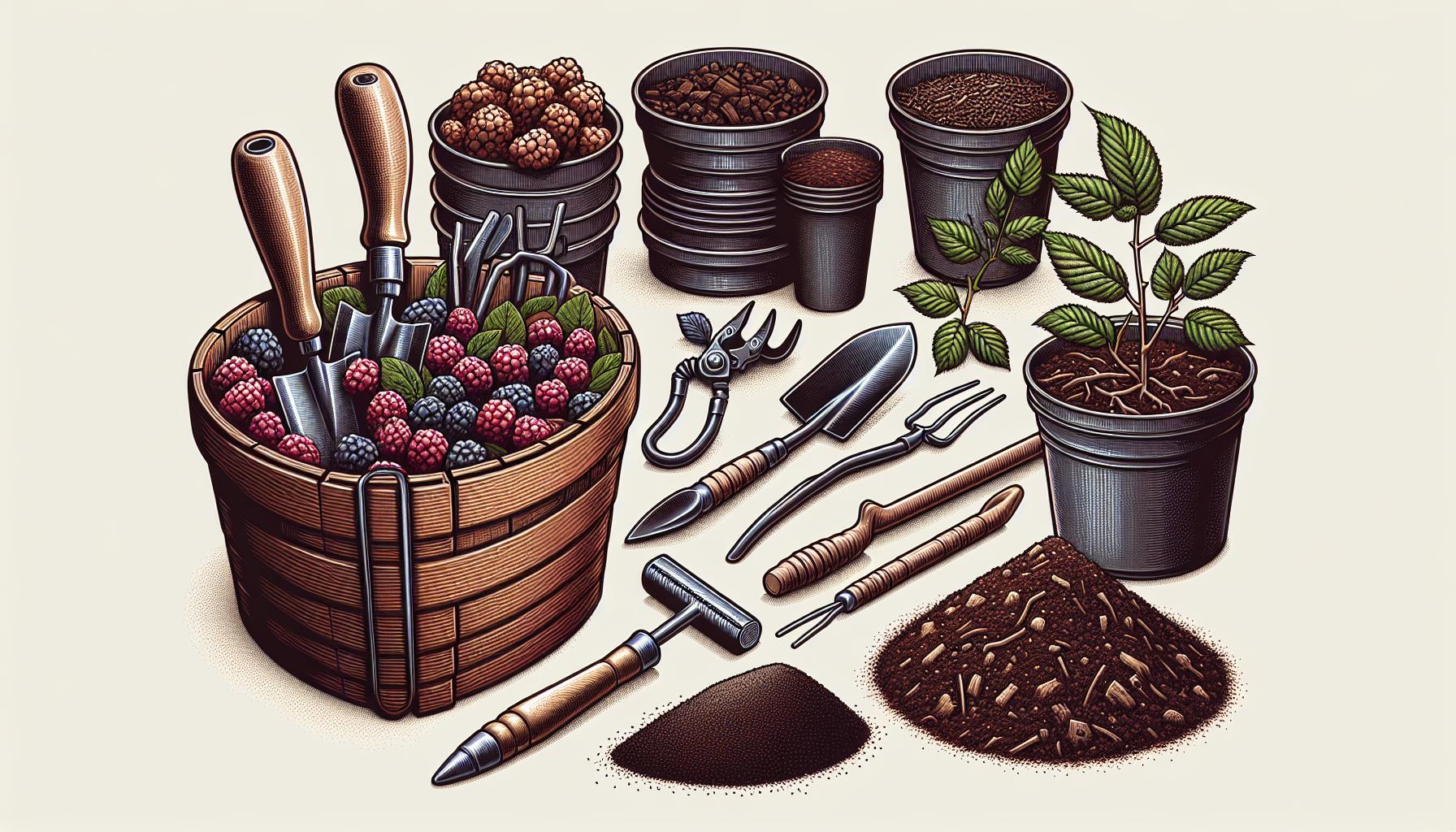
When it comes to growing raspberries in pots, selecting the right soil mix is paramount. Your raspberry plants will thrive in a soil blend that ensures good drainage and aeration while also retaining enough moisture to keep the roots healthy. Here’s what you need to consider:
- Loam-based potting compost: This type of compost is ideal as it provides a balance between moisture retention and drainage.
- pH level: Raspberries prefer slightly acidic soil, with an optimal pH ranging from 5.5 to 6.5.
- Organic matter: Incorporate well-rotted manure or garden compost to nourish your plants and boost their growth.
The Ideal Composition
For the best results, your soil mix should include:
- One part loam-based potting compost
- One part peat-free and pH-balanced compost or ericaceous compost
- A generous amount of organic matter like composted bark or leaf mould
Making your own mix allows you to control the quality and consistency essential for your raspberry plants’ health. If you’re buying pre-mixed soil, always check for the composition and ensure it’s suitable for fruiting plants.
Drainage Enhancements
Improve your soil mix’s drainage by adding:
- Perlite
- Vermiculite
- Sand
These amendments prevent soil compaction and improve moisture regulation, critical for preventing root diseases often caused by poor drainage.
Remember, your raspberries’ health and fruit production are closely tied to the soil they’re in. By choosing the proper soil mix, you provide a strong foundation for your plants to yield those juicy, delicious fruits you’re looking forward to.
Picking Raspberry Varieties for Container Gardening
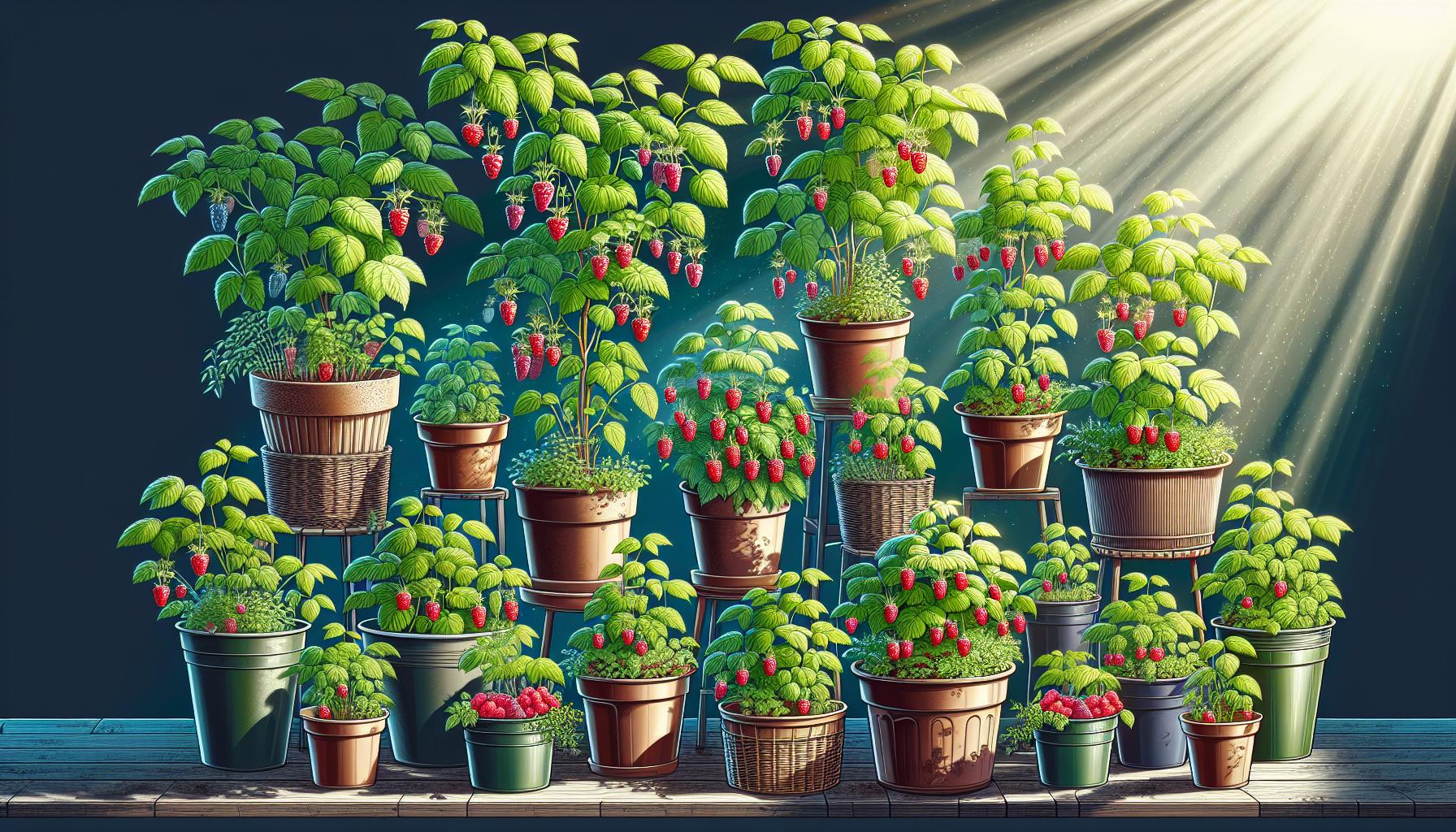
When you’re selecting raspberry plants for your container garden, it’s crucial to choose varieties that thrive in confined spaces. Dwarf and compact cultivars are particularly well-suited for pots, as they require less room to grow than traditional raspberry bushes.
Best Varieties for Pots
Several raspberry varieties are known for their suitability in pots:
- Ruby Beauty: A dwarf variety that does not require staking, making it perfect for containers.
- Autumn Bliss: Known for its early fruiting and tolerance to confinement.
- BrazelBerries Raspberry Shortcake: Specifically bred for container growth, this bush has a compact, rounded habit and is thornless.
- Heritage: An ever-bearing variety that can produce fruit on its current-year canes.
- Space Efficiency: They make the most out of limited space.
- Mobility: Pots can be moved to capture optimal sunlight.
- Soil Control: You manage the soil quality directly, crucial for the pH-sensitive raspberries.
- Disease Management: Containers can help prevent the spread of soil-borne diseases.
When planting your selected raspberries in pots, position them in an area that receives full sun for a minimum of six hours daily. Regular watering is vital, but be cautious of overwatering, as raspberries are prone to root rot in excessively moist conditions. Feed your plants with a balanced fertilizer during the growing season for the best yield, and keep an eye out for pests common to raspberries regardless of their growing environment. With the right care, container-grown raspberries can be just as productive as those planted in the ground.
Planting and Care Instructions
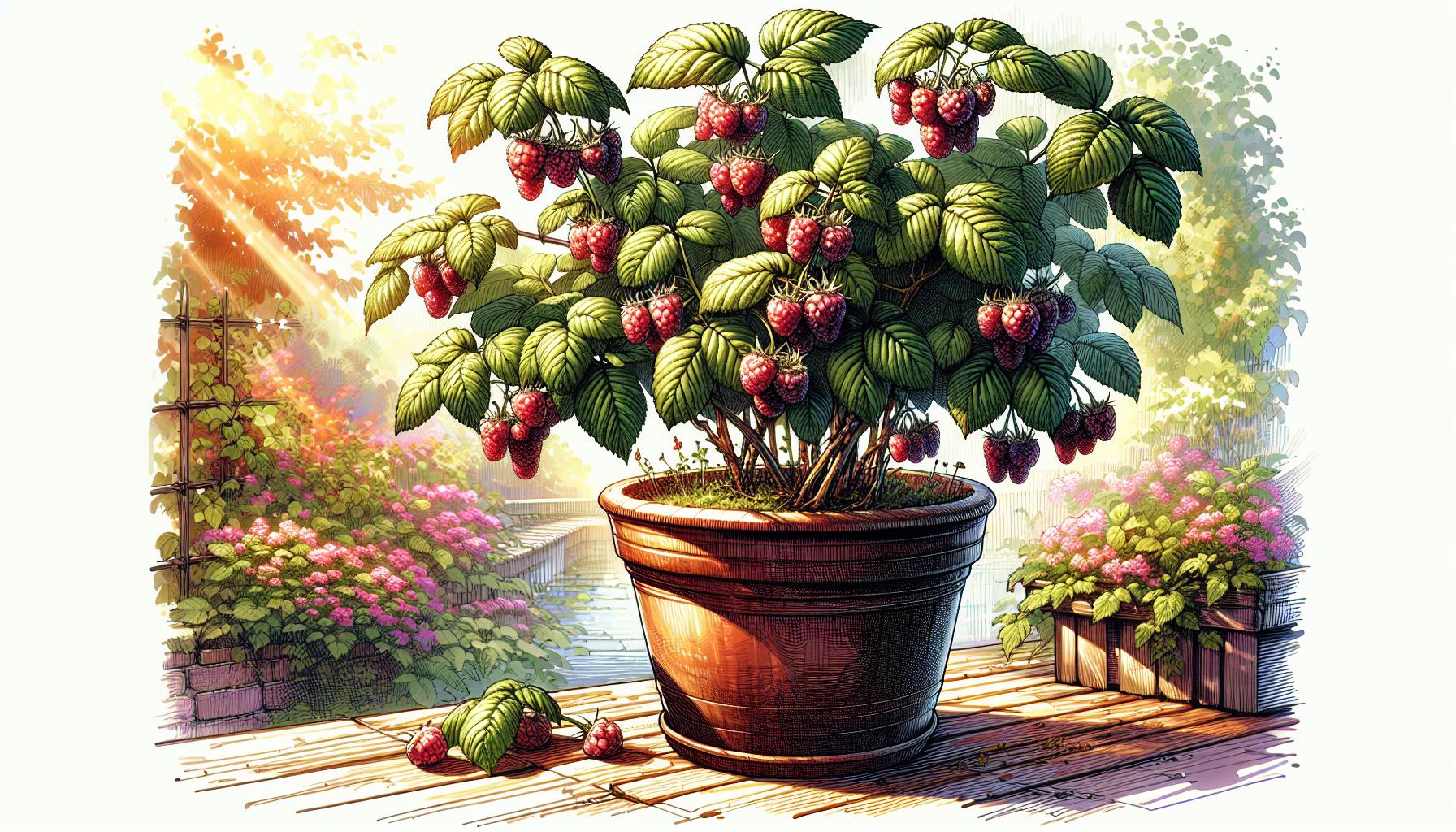
When you’ve chosen the right soil mix and raspberry varieties for your containers, it’s time to focus on planting and ongoing care to ensure your plants thrive. Remember, healthy plants start with proper planting.
Selecting the Right Container
Your container should accommodate the root system of your raspberry plant. Look for pots that are at least 38-50 cm in diameter. Ensure they have adequate drainage holes to avoid waterlogging, which could lead to root rot.
Planting Your Raspberries
Plant your raspberries in early spring. Place a layer of gravel or broken terracotta at the bottom of your pot before adding soil to improve drainage. Space the canes 45-60 cm apart, covering the roots with 8-10 cm of soil. Water your raspberries thoroughly after planting.
Sunlight and Positioning
Raspberries need at least 6-8 hours of sunlight daily. Position your pots in a sunny spot, turning them occasionally to guarantee even sunlight exposure which promotes balanced growth and fruit production.
Watering
Keep the soil moist but not waterlogged. Raspberry plants in pots may require more frequent watering than those in the ground, especially during warmer months. ### Feeding
Feed your raspberries with a balanced fertilizer once a month during the growing season. You can also add a slow-release fertilizer to the potting mix at the time of planting for sustained nutrition.
Pruning and Support
Raspberries will need pruning to remove dead wood and encourage new growth. Provide a support system, like a trellis, for the canes to grow up and prevent them from falling over.
By adhering to these planting and care instructions, you’re on the right path to enjoying succulent raspberries from your very own container garden.
Providing Adequate Watering and Fertilization
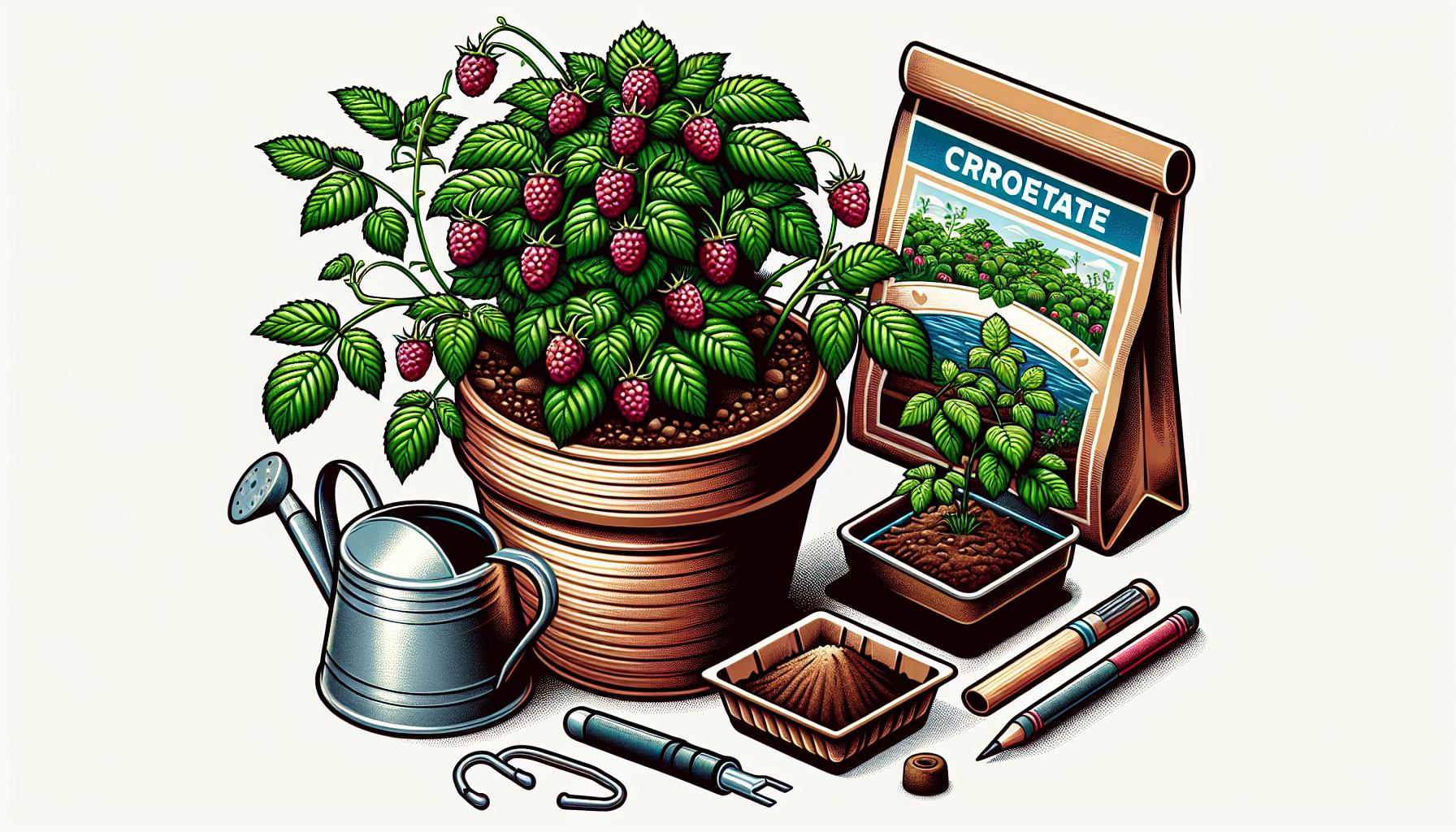
Maintaining a consistent watering schedule is crucial for your raspberries to thrive. Raspberries prefer moist soil, but it’s essential to avoid over-watering as this can lead to root rot. During the growing season, water your raspberries deeply once or twice a week, depending on the weather conditions. Ensure you’re providing at least an inch of water with each session. Using a mulch layer of organic material like straw or wood chips can help retain soil moisture and suppress weeds.
Fertilization plays a vital role in the health and productivity of your raspberry plants. A balanced 10-10-10 fertilizer applied in early spring helps promote healthy growth. Also, you might want to consider a mid-season boost. Here’s an easy-to-follow fertilization schedule:
- Early Spring: Apply a balanced granular fertilizer
- Mid-Summer: Top up with a small amount of high-potassium fertilizer to support fruiting
Use fertilizers according to the instructions on the label, and always water the soil well after applying to prevent root burn and ensure nutrients are well-absorbed. Remember, container plants may require more frequent fertilization than those in the ground, as nutrients can be more rapidly depleted from the potting soil.
Monitoring your plants for signs of nutritional deficiencies is important. Yellowing leaves or poor fruit production may indicate that your raspberries require more of a particular nutrient. But beware of over-fertilizing as this can damage your plants just as much as under-fertilizing.
By striking the right balance with both watering and fertilization, your container raspberries will have the best chance of producing bountiful, flavourful fruit. Keep a close eye on the moisture level of your soil and the general health of your plants to gauge whether your care routine is on track.
Controlling Pests and Diseases
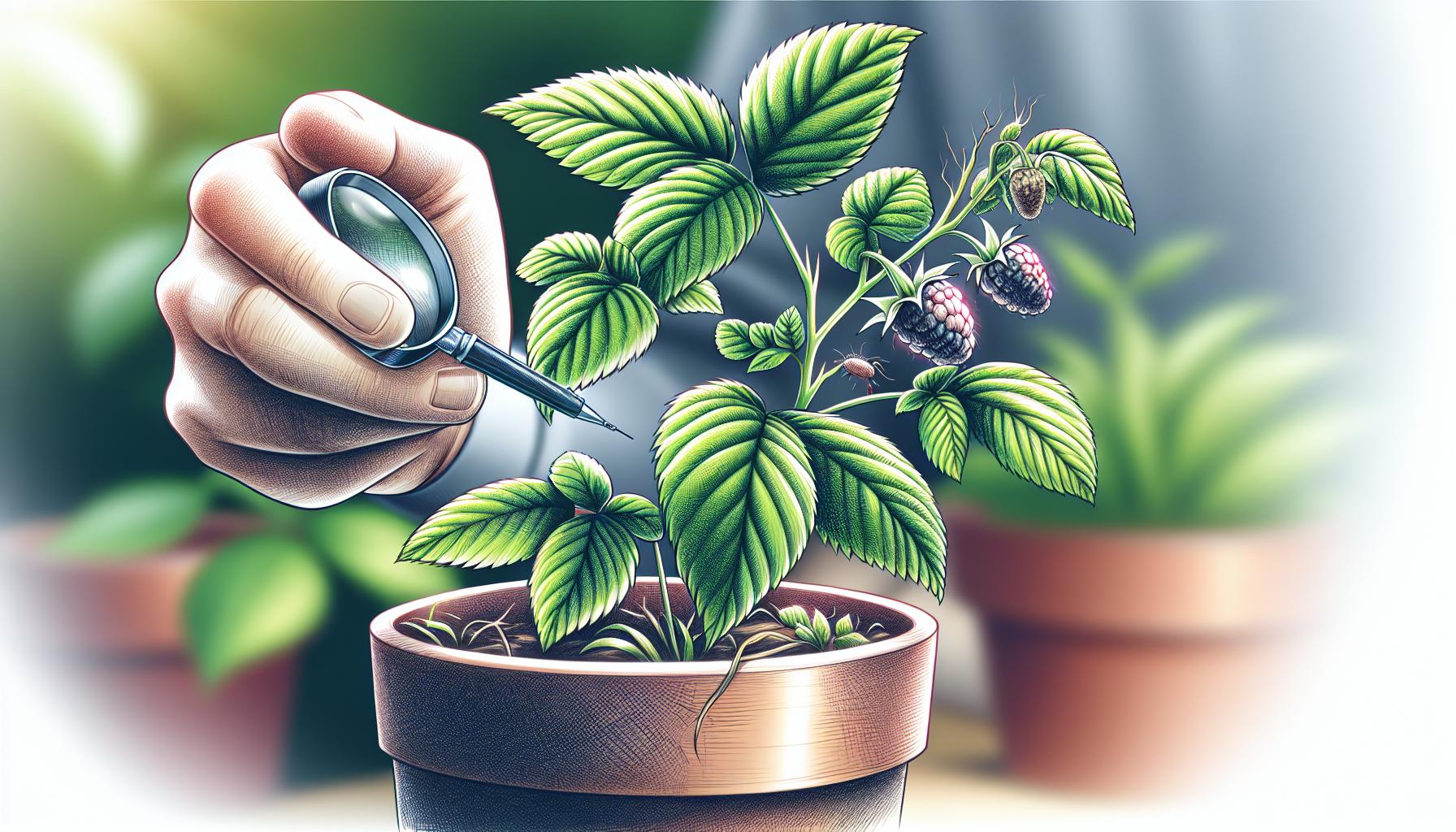
When you’re growing raspberries in pots, vigilance is your best defence against pests and diseases. Your container raspberries can be susceptible to various pests such as spider mites, aphids, and raspberry beetles. Equally, fungal diseases like botrytis or powdery mildew pose a significant threat to your berry crop.
- Spider mites attack in hot, dry conditions, sucking sap and causing the leaves to mottle and die.
- Aphids can spread viruses while feasting on the raspberries’ soft shoots.
- Raspberry beetles are more concerning; they lay eggs on the flowers and the larvae feed on the fruit.
Fungal diseases typically arise from excessive moisture and poor air circulation. To deter these intruders:
- Regularly inspect your plants for the early signs of infestation or disease.
- Introduce natural predators like ladybirds to tackle aphid populations.
- Use fine mesh netting to protect the plants from beetles and other pests.
- Ensure your pots have good drainage and allow soil to dry out slightly between waterings.
- Apply fungicide treatments early if you notice signs of fungal infection.
Pruning also plays a critical role in disease prevention. By removing dead or diseased canes promptly, you increase air circulation and reduce the habitats where pests can thrive.
Rotate your crops if you’re planting new raspberries annually to prevent the build-up of soil-borne diseases. Always choose disease-resistant varieties when possible to give your raspberries the upper hand against common threats. Remember, healthy plants are less likely to fall victim to pests and diseases, so keep your raspberries well-fed and watered according to the guidelines mentioned earlier.
Tips for Pruning and Training Raspberry Plants
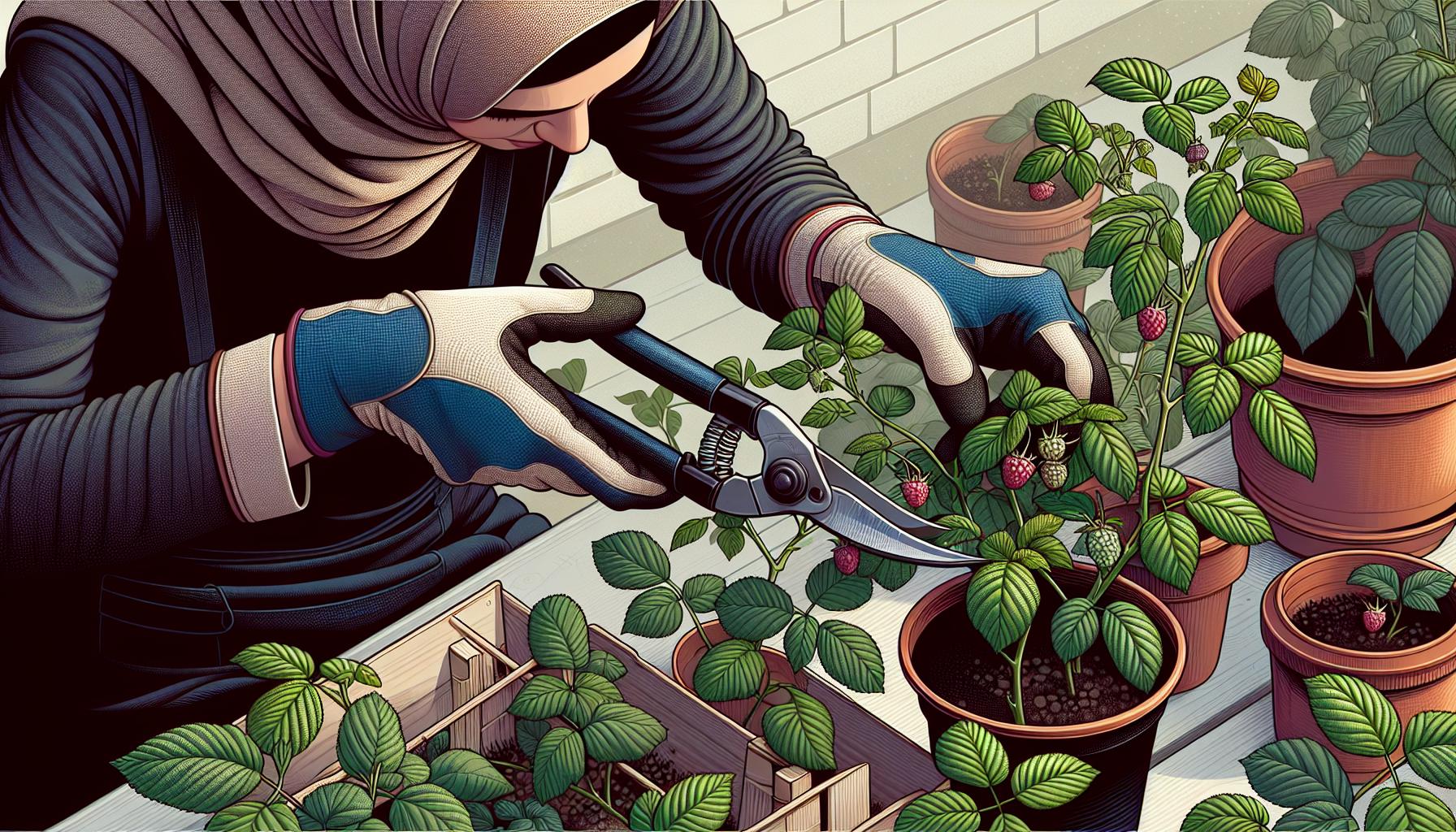
Pruning and training your raspberry plants are critical for ensuring healthy growth and maximizing fruit production. Proper pruning and training can improve air circulation, reduce disease, and allow for easier harvesting. Let’s jump into how you can achieve this for your potted raspberry plants.
Establish Strong Canes
Start by selecting four to six of the strongest canes and removing the weaker shoots at the base. You’ll want to do this early in the spring. This encourages your chosen canes to become productive and strong, providing better support for your fruit.
Summer Pruning
Raspberry plants grow vigorously—often too vigorously. Trim new shoots that emerge in the summer to about 30 cm in height. This prevents crowding and ensures that nutrients are directed to fruit-producing canes.
Support Your Plants
When your raspberries begin to grow, providing support is vital. Use stakes or a trellis system to tie up canes gently. This prevents them from drooping under the weight of their fruit, which could lead to berries spoiling on the soil.
Winter Care
After harvesting, prune all canes that have fruited over summer. Cut them back to ground level to make way for new growth. This might seem drastic, but it’s a vital step in encouraging a strong crop for the following year. Also, it’s a good time to tie in new canes that have grown in preparation for the next season.
Remember, when you’re handling your raspberry plants, always wear gloves to protect your hands from thorns. Regular inspections and maintenance, as part of your pruning and training routine, will ensure your potted raspberries thrive year after year.
Harvesting and Storing Raspberries

Harvesting raspberries at the right time is crucial for the best flavour and highest quality. Raspberries are ready to pick when they’re fully coloured and come off the supporting structures easily. It’s typically mid-summer to early autumn when you’ll find ripe fruit on summer-fruiting varieties, with everbearing plants producing a crop in both summer and autumn.
When it’s time to harvest:
- Check plants regularly, as raspberries ripen quickly and can deteriorate if left on the plant too long.
- Use a gentle touch to avoid bruising the berries, picking only the plump, deeply coloured ones.
- Harvest fruit in the morning when temperatures are cooler for optimal freshness.
Storing raspberries correctly is pivotal to maintain their quality post-harvest:
- Place the harvested berries in a shallow container to minimise crushing and store them in your fridge immediately.
- For best results, don’t wash berries until you’re ready to eat them as moisture can invite mould.
- Raspberries can also be frozen for later use. To do so, spread them out on a baking sheet to freeze individually before transferring to an airtight container or freezer bag.
With proper care, your potted raspberries not only contribute to your gardening satisfaction but also provide a delightful, fresh supply of berries for your enjoyment. With attentive pruning, training, and the right harvesting approach, you’ll maximise the yield from your plants every season.
Conclusion
Growing raspberries in pots is not only achievable but also incredibly rewarding. You’ve got the know-how to ensure your potted raspberry plants thrive and bear fruit season after season. Remember, the key to luscious, flavourful raspberries lies in the timing of your harvest and the care you take in storing them. Stick to these guidelines and you’ll enjoy the fruits of your labour—literally. Here’s to your success in creating a bountiful raspberry harvest right from your balcony or patio!
Colin Macmillan is a seasoned entrepreneur and the CEO of Riverwood Landscape, a leading landscaping company based in Canada. He has been at the helm of the company since leaving high school, demonstrating his strong leadership skills and business acumen.
Colin’s expertise lies in various aspects of landscaping, including lawn care, interlocking, sod installation, and commercial maintenance. His hands-on approach and dedication to the craft have been instrumental in building Riverwood Landscape into a reputable brand.
One of his most notable achievements is the creation of a successful landscape franchise that services multiple locations. This accomplishment underscores his strategic thinking and ability to scale operations effectively.
Colin has also had the privilege of working with Guelph Hospital for landscaping and maintenance, a testament to the trust and reliability that his company has earned over the years.
His professional mission is to offer the best services and experiences for customers, a goal that he tirelessly pursues. Colin’s commitment to excellence and customer satisfaction continues to drive the growth and success of Riverwood Landscape.








